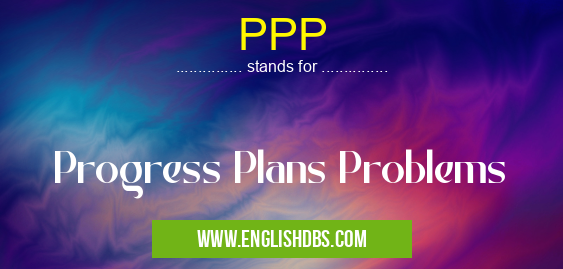What does PPP mean in UNCLASSIFIED
Progress Plans Problems (PPP) is an acronym used in various contexts, primarily in project management and business analysis. It represents a structured approach to identifying and addressing potential challenges and risks associated with a project or business endeavor.

PPP meaning in Unclassified in Miscellaneous
PPP mostly used in an acronym Unclassified in Category Miscellaneous that means Progress Plans Problems
Shorthand: PPP,
Full Form: Progress Plans Problems
For more information of "Progress Plans Problems", see the section below.
Meaning of PPP
- Progress: Refers to the ongoing development and execution of a project or plan.
- Plans: Encompasses the blueprints, strategies, and timelines that guide the project or business initiative.
- Problems: Includes any obstacles, issues, or potential risks that may hinder the successful completion of the project or initiative.
Significance of PPP
PPP plays a crucial role in proactive project management by:
- Identifying Potential Risks: PPP helps identify potential problems and risks early on, allowing for timely mitigation strategies.
- Prioritizing Issues: By classifying problems based on their severity and likelihood of occurrence, PPP enables project managers to prioritize and focus on the most critical issues.
- Developing Contingency Plans: PPP facilitates the creation of contingency plans that outline alternative approaches or solutions in case of unforeseen challenges.
- Improving Communication: PPP serves as a communication tool, fostering transparency and collaboration among project stakeholders.
- Monitoring and Control: PPP provides a framework for monitoring progress, identifying deviations, and implementing corrective actions.
Essential Questions and Answers on Progress Plans Problems in "MISCELLANEOUS»UNFILED"
What is the PPP (Progress Plans Problems)?
The PPP (Progress Plans Problems) is a framework used to identify and address problems that may arise during the execution of a project. It involves continuously evaluating progress and identifying any obstacles or issues that could hinder project success. By proactively addressing these problems, the PPP helps ensure timely and effective project implementation.
What are the benefits of using the PPP?
The benefits of using the PPP include:
- Improved project visibility and control
- Early identification and resolution of issues
- Reduced project risks
- Enhanced communication and collaboration among stakeholders
- Increased project efficiency and effectiveness
How is the PPP implemented?
The PPP is implemented through a structured process that typically involves the following steps:
- Define project goals and objectives
- Identify potential problems and risks
- Develop plans to address identified problems
- Monitor progress and make necessary adjustments
- Communicate progress and issues to stakeholders
What are some common problems that can be identified using the PPP?
Common problems that can be identified using the PPP include:
- Scope creep and changes in project requirements
- Delays in resource allocation and procurement
- Communication breakdowns and stakeholder conflicts
- Budget overruns and financial constraints
- Technical challenges and unexpected events
How can the PPP help to ensure project success?
The PPP helps ensure project success by providing a proactive and collaborative approach to problem-solving. By continuously monitoring progress and identifying potential issues, the PPP allows project teams to address problems early on, before they escalate and become major obstacles. This proactive approach helps to minimize risks, ensure timely and efficient project execution, and ultimately increase the likelihood of project success.
Final Words: PPP (Progress Plans Problems) is a valuable tool for project management and business analysis. It empowers teams to anticipate and address potential challenges, ensuring the successful execution of projects and initiatives. By proactively identifying, prioritizing, and planning for problems, PPP enhances project outcomes, optimizes resource allocation, and mitigates risks.
